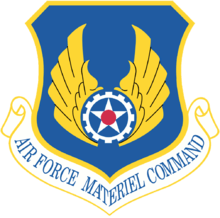Air Force Materiel Command
Air Force Materiel Command (AFMC) is a major command (MAJCOM) of the United States Air Force (USAF). AFMC was created on July 1, 1992, through the amalgamation of the former Air Force Logistics Command (AFLC) and the former Air Force Systems Command (AFSC).
| Air Force Materiel Command | |
|---|---|
 Shield of Air Force Materiel Command | |
| Active | 1 July 1992 – present (27 years, 11 months) |
| Country | |
| Branch | |
| Type | Major Command |
| Role | Deliver and support agile war-winning capabilities[1] |
| Size | 77,416 Airmen 129 aircraft[2] |
| Headquarters | Wright-Patterson Air Force Base, Ohio, U.S. |
| Decorations | Air Force Organization Excellence Award[3] |
| Website | www |
| Commanders | |
| Commander | Gen Arnold W. Bunch Jr. |
| Deputy Commander | Maj Gen Carl E. Schaefer |
| Command Master Chief | CCM Stanley Cadell |
| Aircraft flown | |
| Attack | A-10C, MQ-1B, MQ-9B |
| Bomber | B-1B, B-2A, B-52H[2] |
| Fighter | F-15C/D, F-15E, F-16C/D, F-22A, F-35A |
| Multirole helicopter | HH-60G |
| Utility helicopter | UH-1N |
| Reconnaissance | RC-135V/W, RQ-4B |
| Trainer | T-38C |
| Transport | C-5A/B/C/M, C-12C/D/F/J |
| Tanker | KC-46A,[2] KC-135R/T |
AFMC is headquartered at Wright-Patterson Air Force Base, Ohio. AFMC is one of nine Air Force Major Commands and has a workforce of approximately 80,000 military and civilian personnel. It is the Air Force's largest command in terms of funding and second in terms of personnel. AFMC's operating budget represents 31 percent of the total Air Force budget and AFMC employs more than 40 percent of the Air Force's total civilian workforce.
The command conducts research, development, testing and evaluation, and provides the acquisition and life cycle management services and logistics support. The command develops, acquires and sustains the air power needed to defend the United States and its interests. This is accomplished through research, development, testing, evaluation, acquisition, maintenance and program management of existing and future USAF weapon systems and their components.
History
The United States Armed Forces procurement of military aircraft began when the United States Army's Aeronautical Division of the Signal Corps (United States Army), acquired several examples of the Wright Military Flyer of 1909. USAAF/USAF aircraft Research and Development (R&D) was merged with aircraft procurement twice in the 20th Century (e.g., 1944, 1992).
Air Materiel Command was established on March 9, 1946, and in November 1946, AMC's History Office published Materiel Research and Development in the Army Air Arm, 1914-1945. In 1947, AMC bases were transferred to the newly established United States Air Force, with facilities such as the storage depot in Maywood, California, being renamed Cheli Air Force Station.
On April 1, 1961, as part of the DoD reorganization under President John F. Kennedy and his Secretary of Defense, Robert S. McNamara, the Air Force Logistics Command was established at Wright-Patterson Air Force Base, Ohio, replacing the Air Materiel Command and assuming the latter's supply and maintenance roles. The material procurement role was transferred. On the same date, Air Force Systems Command was also established at Andrews Air Force Base, Maryland, assuming the R&D role of the former Air Research and Development Command while also inheriting AMC's materiel procurement role.[4]
Activation of AFMC, 1992
Air Force Materiel Command (AFMC) was activated on July 1, 1992, as part of a post-Cold War, USAF-wide reorganization that resulted in the merger of AFLC and AFSC into a single major command.
After AFMC was established, the command's infrastructure saw significant reductions through Base Realignment and Closure (BRAC) actions. This included the BRAC-directed closure/privatization of the San Antonio Air Logistics Center at Kelly Air Force Base, Texas and the closure of Kelly Air Force Base as an independent installation, with incorporation of its runways and remaining military flight line areas as the Kelly Field Annex to adjacent Lackland Air Force Base.
The Sacramento Air Logistics Center at McClellan Air Force Base was also closed/privatized and McClellan Air Force Base totally closed. McClellan became a totally civilian airport with the exception of Coast Guard Air Station Sacramento and the Air Force Recruiting Service's 364th Recruiting Squadron.
AFMC Commanders
- General Ronald W. Yates, 1992–1995
- General Henry Viccellio Jr., June 1995 – May/June 1997
- General George T. Babbitt, Jr., May 1997 – 2000
- General Lester Lyles, May 2000 – October 2003
- General Gregory S. Martin, 2003–2005
- General Bruce A. Carlson, 2005–2008
- General Donald J. Hoffman, 2008–2012
- General Janet C. Wolfenbarger, 2012–2015
- General Ellen M. Pawlikowski, 2015–2018
- Lieutenant General Robert McMurry, 2018–2019 (interim)
- General Arnold W. Bunch Jr., 2019–present
Structure
Air Force Materiel Command conducts research, development, test and evaluation, and provides acquisition management services and logistics support.
AFMC headquarters is the major unit located at Wright-Patterson Air Force Base, Ohio. There are also nine additional AFMC host bases:
|
|
|
In addition, the command operates associate units and tenant activities on several non-AFMC bases, including the Air Force Nuclear Weapons Center at Kirtland Air Force Base, New Mexico.[5]
In 2012, there was a major reorganization (5 Center Construct) and several new centers were organized.[6] Among them, the Air Force Sustainment Center at Tinker Air Force Base now directs the Oklahoma City Air Logistics Complex at Tinker Air Force Base, the Ogden Air Logistics Complex at Hill Air Force Base, and the Warner Robins Air Logistics Complex at Robins Air Force Base. The center provides depot maintenance, supply chain management and installation support. In 2015, the command officially activated its sixth center, the Air Force Installation and Mission Support Center, which provides centralized management of installation and mission support. The center is located at Joint Base San Antonio, Texas.
See also
Comparable organizations
- Marine Corps Logistics Command (U.S. Marine Corps)
- Marine Corps Systems Command (U.S. Marine Corps)
- Naval Air Systems Command (U.S. Navy)
- Naval Facilities Engineering Command (U.S. Navy)
- Naval Sea Systems Command (U.S. Navy)
- Naval Supply Systems Command (U.S. Navy)
- Space and Naval Warfare Systems Command (U.S. Navy)
- United States Army Materiel Command
References
- "Welcome". www.afmc.af.mil.
- "Archived copy" (PDF). Archived from the original (PDF) on 2018-04-26. Retrieved 2017-11-29.CS1 maint: archived copy as title (link)
- "Air Force Materiel Command (USAF)".
- "Air Force Systems Command". Air Force Historical Research Agency. 10 January 2008. Retrieved 17 August 2013.
- "Units". Air Force Materiel Command. Retrieved 5 March 2015.
- Tripp, Robert S.; Lynch, Kristin F.; Romano, Daniel M.; Shelton, William; Ausink, John A.; Duran, Chelsea Kaihoi; DeFeo, Robert G.; George, David W.; Conley, Raymond E. (2012). "Air Force Materiel Command Reorganization Analysis" (PDF). Rand Corporation. Retrieved 26 April 2017.
